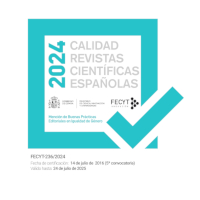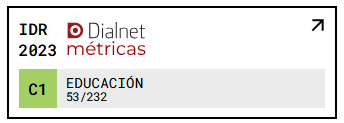Patrones diferenciales en la elaboración de resultados en bebés típicos y bebés con síndrome de Down (1;3 a)
DOI:
https://doi.org/10.18172/con.558Keywords:
Cognitive development, logical action organization, elaboration of results, typical babies, Down’s Syndrome babiesAbstract
The aim of this study is to get to know and compare the logical action organization in the elaboration of results among babies with alternative developmental courses (typical babies and Down’s Syndrome ones with a cognitive developmental level of 1;3 years) from a neuroconstructivist point of view based on infant cognitive development. Using systematic observation, we studied ten babies: five typical babies and five Down’s Syndrome ones. We recorded and coded the spontaneous activity of the babies in a non-verbal behaviour-oriented task that allowed them to elaborate results of different complexity. The sequential analyses, both progressive and retrospective, enabled us to identify the course of action to elaborate results in each groupof babies. From the intra-group behavioural patterns, we established intergroup differences in the process. The results showed a pattern of elaboration of results more complex and flexible in typical babies compared to Down’s Syndrome ones.Downloads
References
Anderson, V., Levin, H. S., y Jacobs, R. (2002). Executive functions after frontal lobe injury: A developmental perspective. En D. T. Stuss y R. T. Knight (eds.), Principles of frontal lobe function (pp. 504-527). London: Oxford University Press.
Anguera, M. T. (1990). Metodología observacional. En J. Arnau, M. T. Anguera y J. Gómez, Metodología de la investigación en Ciencias del Comportamiento (pp. 125-236). Murcia: Secretariado de Publicaciones de la Universidad de Murcia.
Bakeman, R., y Quera, V. (2002). Analyzing Interaction: Sequential Analysis with SDIS and GSEQ. New York: Cambridge University Press.
Bandura, A. (1997). Self-efficacy: The exercise of control. New York: Freeman.
Benes, F. M., Taylor, J. B., y Cunningham, M. (2000). Convergence and plasticity of monoaminergic systems in the medial prefrontal cortex during postnatal period: Implications for the development of psychopathology. Cerebral Cortex, 10, 1014-1027.
Bideaud, J. (1988). Logique et bricolage chez l’enfant: classer et ordenner. Lille: Presses Universitaires de Lille.
Bruner, J. S. (1984). Acción, pensamiento y lenguaje. Madrid: Alianza Editorial.
Cambrodí, A. (1983). Principios de psicología evolutiva del deficiente mental. Barcelona: Herder.
Cambrodí, A. y Sastre, S. (1993). Escales d’Observació Sistemàtica 0-3 anys. Barcelona: P.P.U.
Caughy, M. O., Huang, K., Miller, T., y Genevro, J. L. (2004). The effects of the Healthy Steps for Young Children Program: results from observations of parenting and child development. Early Childhood Research Quarterly, 19, 611-630.
Christoff, K., y Gabrieli, J. (2000). The frontopolar cortex and human cognition: evidence for a rostrocaudal hierarchical organization within the human prefrontal cortex. Psychobiology, 28, 168-186.
Csibra, G., Biro, S., Koos, O., y Gergely, G. (2003). One-year-old infants use teleological representations of actions productively. Cognitive Science, 27, 111-133.
de Kloet, E. R., Sibug, R. M., Helmerhorst, F. M., y Schmidt, M. (2005). Stress, genes and the mechanism of programming the brain for later life. Neuroscience and Biobehavioral Reviews, 29, 271-281.
Diamond, A. (2001). Prefrontal cortex development and development of cognitive functions. En The International Encyclopedia of the Social and Behavioral Sciences, 4 (3), article: 198. London: Elsevier Press.
Diamond, A. (2002). Normal development of prefrontal cortex from birth to young adulthood: Cognitive functions, anatomy and biochemistry. En D. T. Stuss y R. T. Knighte (Eds.), Principles of Frontal Lobe Function (pp. 466-503). London: Oxford University Press.
Erikson, E. (1950). Childhood and society. New York: Norton.
Escolano, E. (2003). Organización y contenido lógico de la acción en bebés típicos y bebés con Síndrome de Down (1;3 a.). Tesis de Licenciatura no publicada. Logroño: Universidad de La Rioja.
Figueras Aloy, J. (2004). Coordinación interdisciplinaria de la atención al recién nacido de alto riesgo. Propuestas de actuación. Bol. Pediatr., 44, 182-184.
Heyder, K., Suchan, B., y Daum, I. (2004). Cortico-subcortical contributions to executive control. Acta Psychologica, 115, 271-289.
Hommel, B. (2003). Planning and representing Intencional Action. TheScientificWorldJOURNAL, 3, 593-608.
Jennings, K. D. (2004). Development of goal-directed behaviour and related self-processes in toddlers. International Journal of Behavioral Development, 28(4), 319-327.
Krippendorf, K. (1980). Content analysis: An introduction to its methodology. Beverly Hills: Sage.
Langer, J. (1980). The origins of Logic: Six to twelve months. New York: Academic Press.
Langer, J. (1982). From prerepresentational to representational cognition. En G. Forman (ed.), Action and thought. Nueva York: Academic Press.
Langer, J. (1986). The origins of Logic: One to two years. Orlando: Academic Press.
Langer, J. (1990). Early cognitive development: Basic funtions. En C. A. Hauert (ed.), Developmental Psychology: Cognitive, perceptuo-motor and neuro-psychological perspectives (pp. 19-42). Amsterdam: North Holland.
Langer, J. (2000). The heterochronic evolution of primates. Cognitive development. En S. T. Parker, J. Langer y L. Mckinney. Biology, Brains and Behavior (pp. 215-236). Oxford: James Currey Ltd.
Leckman, F., Feldman, R., Swain, J. E., Eicher, V., Thompson, N., y Mayes, L.C. (2004). Primary parental preoccupation: circuits, genes, and the crucial role of the environment. J Neural Transm, 111, 753-771.
Mandler, J. (1998). Representation in infancy (selections). En Handbook of Child Psychology, 2 (pp. 268-273). New York: Wiley.
Mareschal, D., y Shultz, T. R. (1997). From neural constructivism to childrens cognitive development. Bridgimg the gap. Behavioral and Brain Sciences, 20 (4), 571.
Mayes, L. C., Swain, J. E., y Leckman, J. F. (2005). Parental attachment systems: neural circuits, genes, and experiential contributions to parental engagement. Clinical Neuroscience Research, 4(5-6), 301-313
Merino, N. (2003). Interacción e interferencia: una perspectiva diferencial y evolutiva (1,3 a.-1;9 a.). Tesis de Licenciatura no publicada. Logroño: Universidad de La Rioja.
Mounoud, P. (1983). L’evolution des conduites de prehension comme illustration d’un modele du développement. En S. Schonen (ed.), Le développement dans la première anneé, (pp. 75-106). Paris: PUF.
Pastor, E. y Sastre, S. (1994). Desarrollo de la inteligencia. En V. Bermejo (ed.), Desarrollo cognitivo (pp. 191-213). Madrid: Síntesis.
Piaget, J. (1976). Le possible, l’impossible et le nécessaire: Les recherches en cours ou projetées au Centre international d’épistémologie génétique. Archives de psychologie, 44(172), 281-299. Trad castellano: Lo posible, lo imposible y lo necesario. Monografías de Infancia y Aprendizaje, 2(número especial de homenaje a Piaget), 1981, 108-121.
Piaget, J. (1983). Piaget´s theory. En W. Kessen (comp.), En Handbook of Child Psychology, 1, (pp. 294-356). New York: Wiley.
Poch, M. L., Ruíz, Y., Sastre, S., Escolano, E., y Merino, N. (en prensa). Incidencia y prevalencia de los factores de riesgo en el desarrollo. Anales de Pediatría.
Poch, M. L., Sastre, S., Merino, N., Escolano, E., Farriol, R., y Gil, J. (2003). Unidades de seguimiento del desarrollo. Revista de Atención Temprana, 6(1), 23-27.
Quartz, S. R., y Sejnowski, T. J. (1994). Beyond modularity: Neural evidence for constructivst principles in development. Behavioral and Brain Sciences, 17, 25-26.
Quartz, S. R., y Sejnowski, T. J. (1997). The neural basis of cognitive development: A constructivist manifest. Behavioural and Brain Sciences, 20(4), 537-596.
Reynolds, A. J. (2004). Research on early childhood interventions in the confirmatory mode. Children and Youth Services Review, 26, 15-38.
Sastre, S. (1996). Estudios de desarrollo cognitivo precoz: alcance, aplicaciones y límites en el proceso de deficienciación. Universitas Tarraconenses (Revista de Psicología), 18(2), 77-107.
Sastre, S. (2001). Desarrollo cognitivo diferencial e intervención psicoeducativa. Contextos Educativos, 4, 95-117.
Sastre, S. (2005). Tutoring Adjustment And Infants’ Cognitive Gain. En L. Anolli, S. Duncan Jr, M. S. Magnusson y G. Riva (eds.), The Hidden Structure of Interaction: From Neurons to Culure Patterns (pp. 195-206). Amsterdam: IOS Press.
Sastre, S., Bretón, P., Escorza, J., Lázaro, V., Pascual, M. T., Poch, M. L., Soares, Y., y Merino, N. (2000). Desarrollo cognitivo e inhibición, prevención e intervención en La Rioja. Memoria de investigación. Consejería de Salud de la Comunidad Autónoma de La Rioja.
Sastre, S., Bretón, P., Escorza, J., Lozano, R., Pascual, M. T., Poch, M. L., Ruiz, Y., Soares, Y., Merino, N. y Escolano, E. (2003). Cognición Temprana Diferencial y Función Ejecutiva. Memoria de investigación. Consejería de Salud de la Comunidad Autónoma de La Rioja.
Sastre, S., Escolano, E. y Merino, N. (2004). Observación sistemática de la cognición temprana: funciones ejecutivas, lógica e interacción. Metodología de las Ciencias del Comportamiento, volumen especial, 557-566.
Sastre, S. y Pastor, E. (2001): Modalidades de tutela de “gestión cognitiva” en bebés trisómicos. Infancia y Aprendizaje, 93, 35-52.
Sommerville, J. A., y Wordward, A. L. (2005). Pulling out the intentional structure of action: The relation between action processing and action production in infancy. Cognition, 95, 1-30.
Stuss, D. T., y Knight, R. T. (2002). Introduction. En D. T. Stuss y R. Knight (eds.), Principles of Frontal Lobe Function (pp. 1-7). New York: Oxford University Press.
Vargas, J. D. (1999). Modalidades sociocognitivas de construcción del saber en la interacción entre iguales en las primeras edades. Tesis Doctoral inédita. Universitat Rovira i Virgili, Tarragona.
Verba, M. y Sastre, S. (2001). Les interactions de tutelle avec les bébes normaux et les enfants trisomiques: l’apport de l’enfant dans l’ajustament de l’adulte. Enfance, 2, 197-214.
Villares, L. (1999). Modalidades de tutela paterna y efectos en el desarrollo cognitivo del hijo (1;0 – 2;0 a.) Tesis doctoral inédita. Universidad Rovira i Virgili, Tarragona.
Woodward, A. L. (1998). Infants selectively encode the goal object of an actor’s reach. Cognition, 69, 1-34.
Woodward, A. L. (2004). Infants’ use of action knowledge to get a grasp on words. En D. J. Hall y S. R. Waxman (eds.), Weaving lexicon. Cambridge, MA: MIT Press.
Woodward, A. L., y Guajardo, J. J. (2002). Infants’ understanding of the point gesture as an object-directed action. Cognitive Development, 83, 1-24.
Woodward, A. L., y Sommerville, J. A. (2000). Twelve-month-old infants interpret action in context. Psychological Science, 11, 73-77.
Woodward, A. L., Sommerville, J. A., y Guajardo, J. J. (2001). How infants make sense of intentional action. En B. F. Malle, L. J. Moses y D. A. Baldwin (eds.), Intentions and intentionally: Foundations of social cognition (pp. 149-169). Cambridge, MA: MIT Press.
Zacks, J. M., y Tversky, B. (2001). Event structure in perception and conception. Psychological Bulletin, 127(1), 3-21.
Zelazo, P. H., Craik, F. M. I., y Booth, L. (2004). Executive function across the life span. Acta Psychologica, 115, 167-183.
Downloads
Published
How to Cite
Issue
Section
License
The authors retain copyright of articles and authorize Contextos Educativos. Revista de Educación the first publication. They are free to share and redistribute the article without obtaining permission from the publisher as long as they give appropriate credit to the editor and the journal.
Self-archiving is allowed too. In fact, it is recommendable to deposit a PDF version of the paper in academic and/or institutional repositories.












